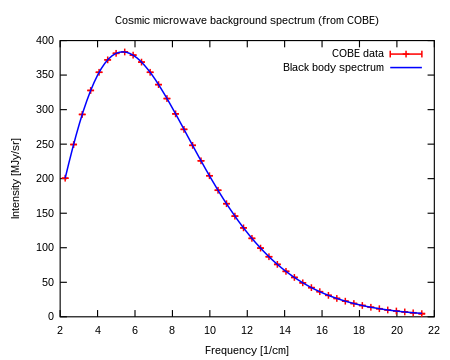No-one who takes science seriously does so because they are “simply believing things you’ve been told.” That might happen if you’re being spoon-fed by Answers in Genesis, but it does not happen when you learn science properly.
When you study science at university, you spend about half your time in something called a laboratory. This is a place where you learn, through hands-on experience, that (a) science has rules, (b) the rules work as described, and (c) you are not at liberty to disregard them. If that isn’t enough to convince you, you are then sent out into the workplace where you have to put the rules into practice in situations where disregarding them could get you fired, or in some cases possibly even result in people getting killed.
And scientists do not use their ears to listen to the cosmic microwave background. They use electronic
sensors, which are far more precise and reliable, and that result in measurements. The measurements can then be plotted on graphs such as this one:

This is a graph plotted from measurements taken from the cosmic microwave background by these electronic sensors. The cosmic microwave background is made up of a whole spectrum of different electromagnetic waves with different frequencies, and the sensors measure the strength of the contribution that each frequency makes to the overall background signal. The x axis of the graph represents the frequency, and the y axis represents the strength of the contribution that that frequency makes, or in other words its intensity.
The resulting curve has a very precise and specific shape called a black body radiation spectrum. It is exactly the same as what you would get if you took similar measurements from a totally black object at a particular temperature. In the case of the cosmic microwave background, this temperature is 2.7 Kelvins, which is exactly what you would expect from a Big Bang occurring about 13.8 billion years ago.
And bear in mind that this is just one set of measurements that scientists can and do take. These measurements are precise; they are detailed; they are numerous; and they have demonstrable extensive cross-correlations between them that are exactly what would be expected from a Big Bang.
Sigh. Yet another young earthist attack piece on radiometric dating that overlooks one important piece of information.
There is a difference between “doesn’t always work” and “never works.”
The only thing that this article manages to demonstrate is that some radiometric methods don’t work properly when applied to some types of rock. Scientists know that fine, they have never claimed otherwise, and they take it into account. But there is a massive difference between that and demonstrating that all radiometric methods could be consistently out by a factor of a million when applied to every type of rock.
The studies concerned were all conducted in the 1960s and 1970s when radiometric dating was still a relatively immature discipline. There have been a lot of advances in the past fifty years that manage to work round the assumptions that were required back then. Isochron dating, AMS spectrometry, argon-argon dating, higher-precision techniques, and a whole lot more.
The article’s claim that scientists only use “evolutionary presuppositions” when identifying rock samples that have been subjected to contamination, alteration or weathering is a straight-up lie. There are a lot of other ways that scientists can tell when samples are likely to have a more complex history. Such as, for example, actual physical damage. Or a chemical composition showing that they were formed from mixing of two different minerals. Or nearby environmental features such as groundwater, volcanic hotspots, metamorphism or folded and fractured rocks.
All in all, this is simply another attack piece that attempts to discredit an outdated and oversimplified cartoon caricature of radiometric dating that does not accurately reflect what real scientists actually do in reality in the present day.
In any case, even if radiometric dating really were as unreliable as Answers in Genesis makes it out to be, that still wouldn’t reduce the age of the earth down to six thousand years. Why? Because some radiometric techniques set lower limits on the ages of the rocks that they are measuring. One example here is uranium-lead dating of zircon crystals. This works because it is physically impossible to get lead into a zircon crystal through any route other than nuclear decay from uranium. On top of that, if the zircons were disturbed in any way (in particular, through being heated up), the lead would escape faster than the uranium, making the clocks look younger than they really are. And if nuclear decay rates ever had been high enough to get millions of years’ worth of lead into the zircons in a much shorter time, they would have released enough heat to destroy them altogether.
